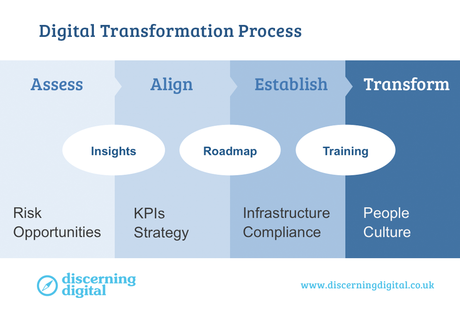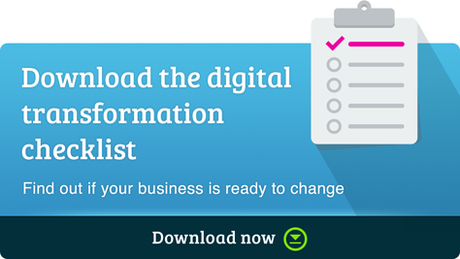Universities and consultancies commonly identify synchronicities between their work and form alliances; Capgemini Consulting with MIT, and Forrester with Stanford University.
Now Discerning Digital is partnering with one of the top universities in the North West region, Manchester Metropolitan University, exchanging knowledge on digital innovation.
We were delighted to be asked to guest lecture for the Digital and Social Media Master’s students on why businesses must embrace digital transformation, and we wanted to share our insights with anyone who is considering digital transformation in their business.

What is Digital Transformation?
As a discipline, digital transformation is enormous and encompasses a lot of sub-disciplines you may be familiar with, including big data, gamification and cloud computing. We believe when defining digital transformation it’s important to speak simply and not over-complicate things, so here’s our definition of what it means:
“Digital transformation simply refers to the changes and challenges associated with digital technology, across all aspects of business.”
Read a more in-depth definition here.
What’s Driving Digital Transformation?
Digital disruption and the rise of the connected customer are the key drivers of digital transformation.
Digital disruption is rapidly moving across a range of industries, most famously in media and publishing, but now reaching previously 'untouchable' sectors.
“Today’s leading companies are already becoming obsolete. In 10 years, 40% of the Fortune 500 was replaced.” Brian Solis, principal of Altimeter Group.
This quote reveals the depth, scale and speed at which digital disruption is happening to even the largest and most established of businesses.
The connected customer is another important driver of digital transformation.
The increasing prevalence of sophisticated digital technologies and social media means that customers are consuming content in entirely new ways and demanding more from their relationships with businesses.
The connected customer can share, research and review products and services online long before making contact with you, marking an enormous power shift.
The ‘Trust Revolution’
This power shift is evident in a research report conducted by Neilsen, Trust in Online, Social and Mobile Advertising Grows, which revealed that trust in paid media is fast (and perhaps unsurprisingly) declining.
What is surprising, however, is the trust placed in emails with 50% of respondents reporting they trusted emails they had opted in to receive. Even more significant was the fact that 58% of people would trust information on branded websites, the same as editorial / newspapers.
This tells us businesses must invest in their reputation and their relationships with customers online.
What’s Practically Involved in Digital Transformation?
We’re passionate that digital transformation should be about customers and people, not based solely on technology. There’s no denying that digital infrastructure is an intrinsic part of any transformation, but we’ve found that digital transformation involves all teams and functions of your business, not just your digital or IT teams or activities.
Key components of digital transformation commonly include:
- Customers, marketing, sales and content.
- Technology, infrastructure, IT, data.
- Analytics, monitoring, benchmarking.
- Process, management, efficiencies.
- Finance, legal, compliance.
- People, HR, culture.
The Process of Digital Transformation
We’ve defined a transformational process that can help turn an overarching digital transformation into manageable projects, so you can keep control of your timings and costs.
For more info on process in digital transformation, click here.
Why You Must Transform
Digital transformation is becoming an imperative for businesses of all sizes and industries. The only certainty at this point is that change is accelerating.
Customer behavior is driving this change and if you want to find, keep and retain online customers as well as stay ahead of the competition, you must consider digital transformation.
Tell us what you think - have we encapsulated the urgency of digital transformation?


